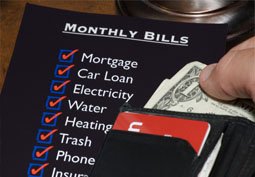This post will give you the steps you need to take to get financially organized for 2014. Many people just aren’t sure where to start with their finances. Here you’ll find you items to consider in some of the main financial planning categories and a link to a printable 2014 Financial Organization Checklist with actionable strategies for you to take, boxes to check off and spaces to fill in and go through on your own. So stop stressing about your money and start writing down your goals and checking in on your financial status.
GOALS
Take some time to sketch out what you’re looking to accomplish in 2014 and set S.M.A.R.T. goals for yourself (Specific, Measurable, Attainable, Relevant, Timely).
Do you want to pay off debt? Buy a new home? Plan a wedding? What are the numbers associated with each? What about your timeframe?
An example of your goal may be:
“I want to pay off $7,000 of student loans in the next 12 months.” or “We want to create a budget that only has us spending $10,000 for our wedding in October.”
Writing down your goals and putting them in a place where you can see them on a daily basis will help you to hold yourself accountable.
My personal coach recommended I have a post-it note with my goals on it on my bathroom mirror so that I see them every morning and evening.
SPENDING
Tracking your spending is important because it allows you to identify where your money is currently going so you can make the necessary adjustments to get on track and reach your goals.
Are you tracking your spending? If you aren’t using a website such as Mint.com, you should be. Sign-up and sync up your credit card and bank accounts to automatically analyze your spending.
Review your spending monthly and remember to refrain from big impulse purchases and instead create a plan for saving the funds needed to buy.
DEBT
Three items to be aware of on all debt balances are:
- Outstanding balance
- Interest rate
- Monthly payment
For debt pay down, follow either the snowball approach when paying off your debt (which has you pay off debts in order of smallest balance to largest so you build momentum) or work to put any extra funds towards the highest interest rate balance and get that balance paid off first. Then allocate funds towards the next highest and so on.
SAVING
Do you have an emergency fund? I recommend having 3-6 months of expenses stashed away in a rainy day fund. This cash will help you out in the event of a job loss, unexpected home or car repair or injury. Feel overwhelmed with that number? Work to set aside one month of expenses.
How are you paying yourself? Have savings amounts automatically deducted from your paycheck and/or transferred from your checking account. Automating will allow you to treat your savings like a bill payment and anything left over will be yours to spend and work with.
RETIREMENT
The max contribution for Roth and IRA accounts in 2014 is $5,500. This means that by putting away $458.83/month, you can MAX OUT your contributions for the year.
The max contribution for your Roth and Regular 401(k)s is $17,500. By putting away $1,458.33/month you can MAX OUT your contributions for 2014.
INSURANCE
Review your deductibles, premiums and coverage.
Do you have:
- Auto coverage
- Are you protected against uninsured or underinsured motorists?
- Renter’s insurance
- Homeowner’s Insurance
- Life Insurance
- Disability Insurance
- Umbrella insurance
Have you:
- Asked about discounts?
- Bundled coverages?
- Looked into increasing your deductible to reduce your premium (if you have the funds on hand to cover the deductible)?
- Updated coverages if you were married, had children or took on debt?
ESTATE PLANNING
When thinking about your need for an estate plan, consider the following:
- How do you want your personal assets to be distributed?
- Who stands to inherit them?
- Are there certain items or gifts that you would want to go to specific people?
Do you have:
- A Will?
- Durable Powers of Attorney for Finances and Healthcare?
- Advanced Healthcare Directive?
- Guardianship Provisions?
- Trust?
Review these documents annually:
- Estate planning documents
- Beneficiary Designations
Once in place, your estate plan (including any beneficiary designations on retirement accounts or life insurance policies) should be reviewed annually to ensure documents and designations remain aligned with your current state of affairs and wishes.
No matter what your estate looks like, at a minimum you should work with a trusted estate planning attorney to ensure you have a will, durable power of attorney, advanced healthcare directive, and durable medical power of attorney in place should you ever be faced with one of the situations listed above.
LIFE TRANSITIONS
Have any of these transitions occurred in your life in 2013 or planned for 2014?
- Engaged or Married
- New Job or Career
- Home Purchase
- Baby on Board
- Started or Running a Business
If so, it may be a sign that you need a financial planner. Contact me today for a free 30-minute focus session to discuss your financial life and goals.
Click here to go to the PRINTABLE 2014 Financial Organization checklist.
What are your financial goals for 2014?
Mary Beth Storjohann, CFP® is the Founder of Workable Wealth and is a Financial Planner for Gen Y. She works as a writer, speaker and financial coach and is passionate about working with individuals and couples in their 20s and 30s to help them plan for and navigate through the financial questions and issues that arise during their post-quarter-life transitions. You can also follow Mary Beth on Twitter and Facebook.



